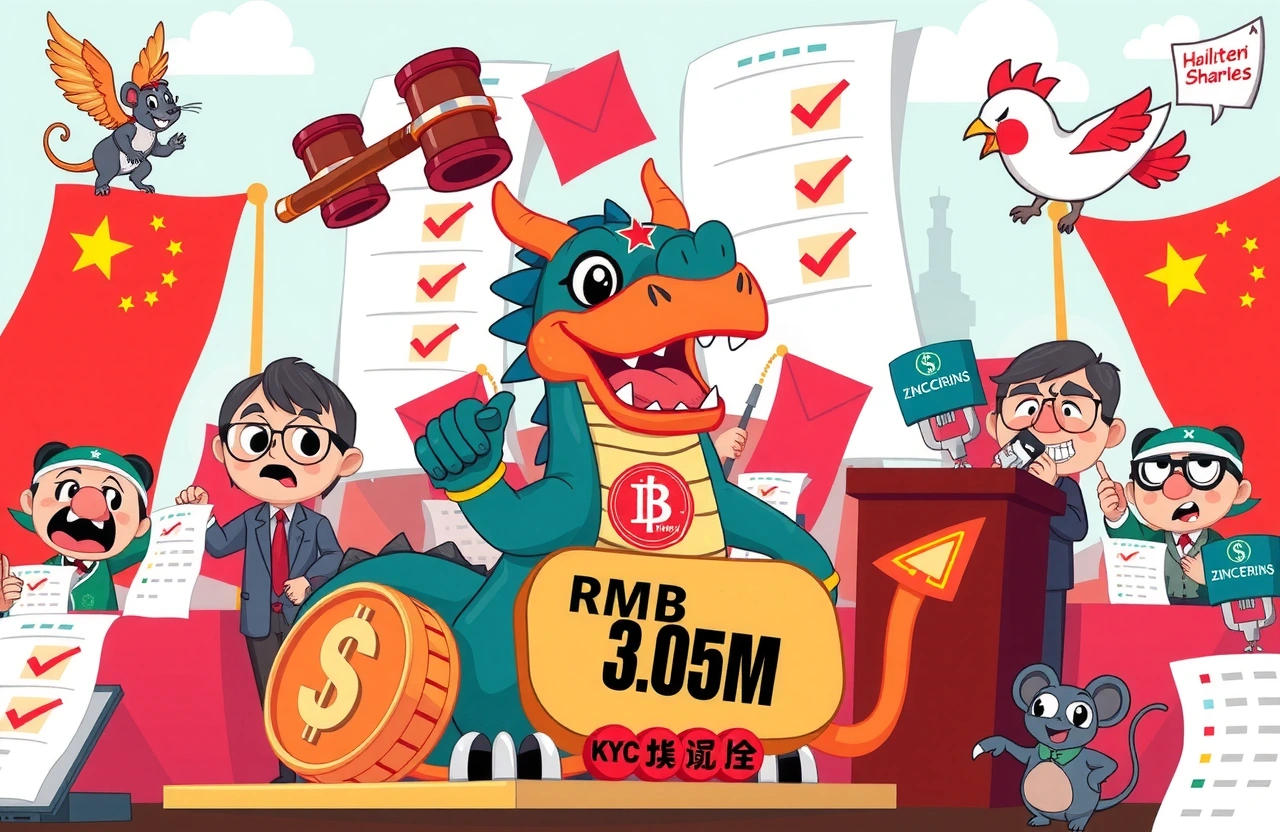– Zhengxin Bank fined RMB 3.05 million ($425K) by Shanghai PBOC for violating AML rules and financial reporting requirements
– Three senior executives including Vice President Guo Moujiang (郭某江) fined individually for compliance failures
– Core violation centered on improper customer due diligence under Article 9 of China’s AML regulations
– Case highlights China’s intensified surveillance of financial institutions amid money laundering risks
– Banks urged to overhaul compliance frameworks to avoid regulatory penalties
When financial regulators impose multi-million yuan penalties, markets pay attention. The People’s Bank of China (PBOC) Shanghai branch recently fined Zhengxin Bank RMB 3.05 million ($425,000) for failing to comply with anti-money laundering regulations—specifically violating Article 9 of China’s AML requirements regarding customer identification protocols. The enforcement marks Shanghai’s latest move in China’s nationwide campaign against financial misconduct, underscoring toughened regulatory stance where senior executives were personally fined for oversight failures. As money laundering risks intensify globally, China’s red lines couldn’t be clearer: banks unable to maintain ironclad anti-money laundering defences face severe consequences.
The Anatomy of Zhengxin Bank’s Regulatory Penalties
PBOC Shanghai’s Enforcement Announcement
The public bulletin from PBOC Shanghai (中国人民银行上海分行官网) detailed two distinct violations triggering Zhengxin’s penalties: failure in customer identity verification requirements plus breaches in financial statistical reporting protocols. This dual citation reflects authorities’ broadening scrutiny beyond AML to encompass broader data integrity requirements for Chinese financial institutions.
Violation Timeline and Investigation
While concrete investigation dates remain undisclosed, banking analysts note patterns in China’s AML enforcement: inspections typically precede fines by 6-12 months.Regulatory timelines suggest Zhengxin Bank’s oversight failures likely occurred during heightened watchdog activities in late 2024 as China strengthened financial defenses against transnational money laundering schemes.
Dissecting the Core Violations
Customer Identification Breakdown Under Article 9
The bank’s most severe offence violated Article 9 of China’s Measures for Anti-Money Laundering Supervision and Administration (金融机构反洗钱监督管理条例), mandating financial institutions establish comprehensive Know Your Customer (KYC) frameworks. Violations manifested through:- Deficient customer background verification workflows
– Inadequate red flag monitoring for suspicious transactions
– Failure to update client risk profiles during business relationships
– Recognition discrepancies resolved without documenting verification trails
Breaches in Financial Statistical Reporting
The secondary infringement involved flawed data submission procedures violating China’s Financial Statistics Reporting Rules. This dual citation underscores how regulators increasingly cross-reference AML compliance with parallel reporting requirements.
Executive Accountability Framework
The PBOC demonstrated unprecedented individual accountability enforcement when penalizing three Zhengxin Bank executives:
Personal Liability Assignments
– Former Deputy General Manager Guo Moujiang (郭某江): Fined RMB 50,000 for KYC system supervision failures
– Former Executive Pan Mouming (潘某明): Fined RMB 20,000 for oversight gaps in transaction monitoring
– Operations Head Xiao Mou (肖某): Fined RMB 50,000 for inadequate procedure implementation
The Expanding Shadow of Executive Liability
China’s banking regulators now routinely trace violation chains to management tiers following key amendments to China’s Anti-Money Laundering Law strengthened in 2024. Senior executives face personal liability for:
– Insufficient compliance resource allocation
– Failure to implement audit recommendations
– Bypassing internal governance protocols
– Weak whistleblower protection environments
China’s Evolving AML Regulatory Architecture
Current AML Legislation Explained
China’s AML regime anchors around:
– Anti-Money Laundering Law of China (2007 amended 2024)
– AML Regulations for Financial Institutions
– Guidance on Customer Due Diligence Reporting drafted by PBOC Financial Intelligence Center
Collectively establishing demanding protocols increasing since China’s FATF mutual evaluation.
Shanghai’s Enforcement Trends
PBOC Shanghai imposed RMB 283 million in AML fines during 2024 according to official statements—up 40% year-on-year. Recent patterns show intensified scrutiny on:
– Cross-border payment processors
– Foreign bank branches
– Virtual currency transactions
– Trade-based money laundering hubs
Strategic Compliance Firewalls for Financial Institutions
Customer Identification Shield Protocols
Financial institutions within China should implement layered defenses against Article 9 violations including:
– Establishing independent KYC remediation teams reporting directly to compliance committees
– Deploying AI-powered transaction monitoring exceeding basic PBOC requirements
– Running simulated AML audits biannually with PBOC-approved consultancies
– Mandating monthly executive certification of AML system integrity
Executive Accountability Frameworks
Senior leadership should institute:
– Quarterly attestations documenting personal compliance oversight
– Implementing tiered bonus structures incorporating AML control performance
– Mandating certification through PBOC-approved compliance leadership programs
– Establishing automated management reporting waterfalls addressing AML exceptions
Regulatory Technology Implementation
– Incorporate Machine Learning algorithms identifying complex laundering patterns missed by rule-based systems
– Establish blockchain-secured auditing trails satisfying reporting requirements
– Deploy API clouds aggregating suspicious activity reports for cross-institutional sharing
Imperatives for Banking Risk Management
The Zhengxin Bank case illuminates China’s hardened enforcement posture where AML failures attract severe institutional penalties and unprecedented personal liability for executives. Within China’s complex anti-money laundering regulations framework, Article 9 requirements now serve as critical compliance milestones with PBOC demonstrating consistent willingness to sanction poorly defended institutions. Banks still relying on manual verifications and fragmented monitoring systems risk forfeiting operational stability in China’s escalating AML battlefield.
The warning blares from Shanghai’s regulatory towers: overhaul compliance frameworks immediately. Commission holistic AML defence audits focusing specifically on client identification workflows before year-end reporting deadlines hit. Engage certified AML consultants to benchmark organizational defenses against Zhengxin Bank inspection gaps—prevention costs exponentially less than RMB 3 million lesson.



